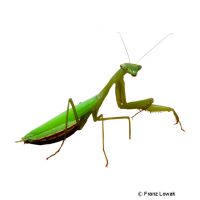Egyptian Praying Mantis (Miomantis paykullii)
| Egyptian Praying Mantis Miomantis paykullii | |
|---|---|
| Name | Egyptian Praying Mantis |
| Name Lat. | Miomantis paykullii |
| Family | Miomantid Mantises |
| Family lat. | Miomantidae |
| Order | Praying Mantids |
| Order lat. | Mantodea |
| Origin | Africa |
| Habitat | Savanna |
| Diet | Flying insects |
| Humidity | 50-60 % |
| Behavior | Predatory |
| Keeping | Individual |
| Care Level | Easy |
| Housing | Dry terrarium |
| Breeding | Moderately difficult |
| Life Span | 6-8 months |
| Protection | No |
| Metric Units | |
| Size | 3-4 cm |
| Temperature Day | 25-30 °C |
| Temperature Night | 20-22 °C |
| Housing Size | 20 x 20 x 30 cm |
| US Units | |
| Size | 1.2"-1.6" |
| Temperature Day | 77-86 °F |
| Temperature Night | 68-72 °F |
| Housing Size | 10" x 10" x 10" |
Distribution and habitat
The range of the diurnal Egyptian praying mantis extends over large parts of sub-Saharan Africa from Senegal and Mauritania to Sudan and along the Nile to Egypt. They inhabit the dry savannas, where they live in shrubs and on grasses.
Maintenance
For a female an insectarium of 20 x 20 x 30 cm (L x W x H), for a group of up to 5 males 30 x 30 x 50 cm, can be recommended as a guideline, which should be placed in a quiet place without direct sunlight. A cover of gauze or fine metal mesh is recommended
You need an insectarium not too densely structured with sufficiently thin climbing branches (hiding places, visual protection) and grasses, a substrate of sand-earth mixture (terrarium humus) and a small, shallow drinking vessel with water gel or a absorbent cotton drinker. Artificial or live plants are suitable for decoration
The insectarium should be finely sprayed lightly with water inside every 2-3 days, preferably in the evening. Too much moisture is not tolerated.
| Temp. day: 25-30 °C | Temp. night: 20-22 °C | Humidity: 50-60 |
The lighting duration should be 12 hrs. Light sources that also produce the necessary heat are ideal.
Diet
They are predatory and seize the prey, preferably flying insects, at lightning speed from an angled lying-in-wait position with their tentacles. The food supply should consist of crickets, house crickets, flies (Drosophila) and wax moths, small butterflies and cockroaches, etc., but also meadow plankton. It is important to regularly add minerals and vitamins (e.g. by dusting the feeders). The quality of the feeders can be enhanced by feeding overripe fruit and honey water. A few days before, during and after molting, they refuse to eat. During molting, no predatory feeders (e.g. crickets) should remain in the insectarium, as during this time the animals are unprotected and may become prey themselves.
A varied diet promotes health and prevents deficiency symptoms.
Reproduction and breeding
Females are larger and stronger than the slimmer males, which have longer wings that extend beyond the abdomen.
About 7 days after mating, the female lays the first egg package (ootheca). Up to 10 more oothecae follow at intervals of about 10 days. After about 6 weeks, about 20-50 nymphs hatch at a temperature of about 28 °C and a humidity of 50-60 %. The young are only a few millimeters long, black in color and resemble ants (mimicry). They should be fed immediately with small fruit flies or microheims so that they do not eat each other (cannibalism)
After the imaginal molt, the animals are ready to mate after about 2 weeks. After that the males live for about 6 months, the females up to 8 months
Important
Prior to mating, a large food animal should be offered to the female to reduce the risk of her eating the male. It is recommended to keep females singly.
They have very good camouflage (mimesis) due to their body shape and coloration and their often prolonged immobility.
Before purchasing, an insectarium should be prepared that meets the species specific needs. Good ventilation without drafts is necessary, as well as equipment for measuring temperature and humidity. The lighting should correspond to the species-specific day-night rhythm and should be placed in such a way that the animals cannot injure themselves. The insectarium should be locked in such a way that neither unauthorized persons can open it nor the animals can escape. Special attention must be paid to thorough hygiene and contamination must be removed regularly.
Further literature can be found in your pet store.
References
Text: petdata; Image: Franz Lowak
Source: HENKEL & SCHMIDT (2010): Taschenatlas Wirbellose für das Terrarium, Verlag Ulmer; ENGELMAN & LANGE (2011): Zootierhaltung - Tiere in menschlicher Obhut: Wirbellose, Verlag Harri Deutsch
